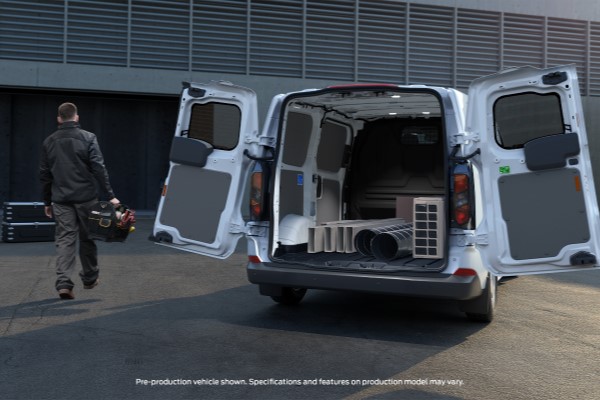Ford Transit Custom arrives in Australia with diesel, dual-cab and EV options
Ford Australia has officially launched the second generation of its Transit Custom medium van into the local market, with the big boxy load-lugger benefiting not just from a whole new platform that’s designed to make transporting goods, tools and other cargo easier, but a range of innovations pitched squarely at making the lives of tradies and delivery drivers a hell of a lot smoother.
Though its form factor might look broadly similar to the now 12-year-old first-generation Transit Custom, the second-gen van is built atop a clean-slate architecture. The new platform enables more powertrain and drivetrain flexibility – across its variants, the Transit Custom can be had with regular combustion engines, as a hybrid, or as a fully electric vehicle, plus boasts the choice of FWD, AWD and RWD – but, crucially, it liberates more space on the inside as well.
ADVERTISEMENT
Most of that extra space is gained in the front of the cabin, with the front wheel wells now pushed to the very corners of the platform to give drivers and front occupants a clear, flat and unobstructed floor. The dashboard has also been comprehensively reorganised. The passenger front airbag is now mounted in the roof rather than the dash pad, which means there’s now heaps more storage for paperwork, computers, tools and whatever else a working driver needs, while the gear selector has migrated to the steering column to give occupants the ability to easily slide from the left seat to the right seat without knocking their knees on the dashboard.
There are a number of other quality-of-life features as well. Two AMPS mounting points are provided, one in the centre stack and one to the right of the instrument panel, eliminating the need to drill into cabin plastics to mount radios, screens and other accessories, while the steering wheel can tilt down to create a perch for laptops, or a table for eating lunch off – a feature unique to the new-gen Transit Custom. There are three USB-C and USB-A charging ports, and even the map lights have been positioned to avoid casting shadows when writing on documents in the driver’s seat.
Loading cargo is facilitated with the new-generation Transit Custom’s 25mm lower floor height and larger rear door aperture, the latter of which was facilitated by a new hinge arrangement that permits the widest possible opening for barn door-equipped variants. For the side doors, the kerbside door on some models can be opened hands-free via a kick sensor, much like modern passenger cars – ideal for when your hands are full of tools or packages and you can’t fumble for the handle.
In the back, total cargo volume measures in at 6.8m³ for the long wheelbase Transit Custom, or 5.8m³ for the short wheelbase. Payload maxes out at 1,223kg and 12,69kg for the LWB and SWB respectively, while towing capacity is 2,500kg for both bodystyles. Unlike some vans, no high-roof option exists – a deliberate move to ensure that Transit Custom operators are able to easily fit in most height-limited parking garages.
The base model Transit Custom Trend is the first variant to arrive in Australia, offering a generous standard equipment list despite its entry-level positioning. With a 13” infotainment display running Ford’s latest Sync 4 operating system (and also having wireless CarPlay and Android Auto), plus a wireless phone charger, an embedded 5G modem, and a 12” electronic driver instrument display, the Trend’s gear list is already well above the segment norm. Standard driver aids include front and reverse AEB, rear cross-traffic alert, blind spot monitoring, approaching object warning when opening doors, and adaptive cruise control. For the Trend, power is supplied by a 125kW/390Nm turbo diesel inline-four, with an eight-speed automatic as standard. The Trend is priced at $55,990 in SWB form or $56,990 for the LWB, with dual sliding doors listed as a $1,000 option.
The high-spec Transit Custom Sport adds even more gear for a modest increase in price, with LED headlamps, a sporty body kit, soft-close sliding doors, 17” alloy wheels, Sport-specific upholstery, four more USB-C ports, dual-zone climate control, a closable upper glovebox, and a metal cargo bulkhead, for an RRP of $59,990. The Sports grade also introduces another configuration, with a two-row Double Cab option available for an extra $3,000. On top of the single-row Sport, the Sport Double Cab brings an eight-way adjustable passenger seat with armrests, a centre console, a carpeted cabin floor, pop-out glass rear windows, and ISOFIX child seat anchorages in the second row.
Some overseas variants like an AWD model and a plug-in hybrid version aren’t on the radar for Australia, but the Australian Transit Custom range will be capped off when the all-electric E-Transit custom arrives around the end of this year. Pricing has yet to be confirmed (expect it to land somewhere between $70-80K), though key stats are locked in: all E-Transit Customs heading to Australia will be powered by a 160kW/415Nm electric motor driving the rear wheels, supplied energy by a 64kWh battery pack. The maximum range is a claimed 337km, and all E-Transit Customs will have the ability to offload power via a pair of household power outlets next to the rear door, helping keep tools charged while out on job sites.
-
ADVERTISEMENT
-
ADVERTISEMENT


